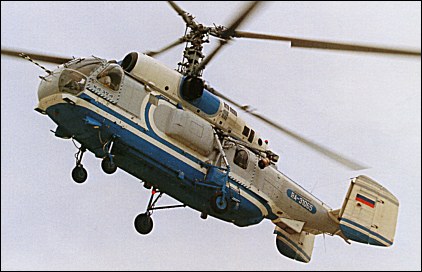
| Kamov Ka-32A 1980 |  |
 |

| Kamov Ka-32A 1980 |  |
 |
|
Ka-32A main roles are: carrying people and cargoes in the transport cabin and bulky cargo on external sling, evacuation of casualties and victims, search and emergency-rescue operations, loading-unloading of the ships in travel and at roadstead, servicing operations of coastal gas and oil pipelines, building-installation operations. Ka-32A helicopter has coaxial rotor layout with two three-blade rotors of 15.9-m diameter each. The polymeric composite blades are folded into stowage position when the helicopter is based on ship decks. Ka-32A is developed on the basis of ship-borne Ka-27 and Ka-28 helicopters and inherited high power-to-weight ratio, maneuverability, capability for all-weather operations including the icing conditions; adaptability of the units, systems and assemblies for aggressive sea water operational conditions. The coaxial rotor layout makes the helicopter safe in maneuvering in the vicinity of obstacles, including in turbulent atmosphere. Ka-32A is unsurpassed in its class, it carries cargo of up to 5000kg on an external sling at the altitude of up to 2500m. In case of one engine failure the helicopter continues safe forward flight and successfully lands. Due to its on-board avionics suite the helicopter is operable 24 hours a day throughout the year and in IFR conditions. The helicopter set 7 world records. Western operators in Switzerland, Canada, Papua-New Guinea, Burma and other countries successfully operate Ka-32A. The helicopter is available in several versions: Ka-32A1 fire-fighting version, Ka-32A2 police version, Ka-32A11BC, Ka-32A12. The aviation registers of Canada and Switzerland have granted type certificates to Ka-323A11BC and Ka-32A12 helicopters.
Assemblies and systems of basic Ka-32 modified in 1990-93 to meet all requirements of Russian NLG-32-29 and NLG-32-33 and US FAR Pt 29/FAR Pt 33 airworthiness standards in categories A and B. First flight September 1990; Russian type certificates obtained for Ka-32A and its TV3-117VMA engines in June 1993. Production began 1996. Larger tyres. Optional pressure fuelling with reduced fuel capacity. Maximum accommodation for 13 passengers. Advanced avionics available, including Canadian Marconi dual CMA-900 flight management system, with EFIS, AFCS, CMA-2012 Doppler velocity sensor and CMA-3012 GPS sensor. Modification of helicopters to Ka-32A standard started by Kamov 1994. Jane's All the World's Aircraft, 2004-2005
|